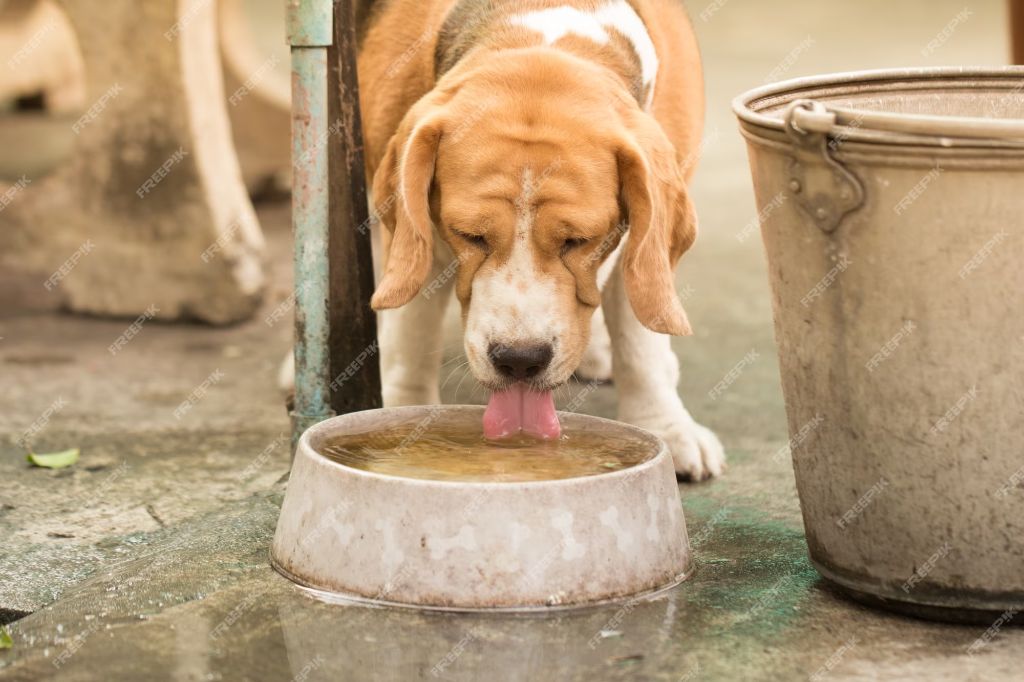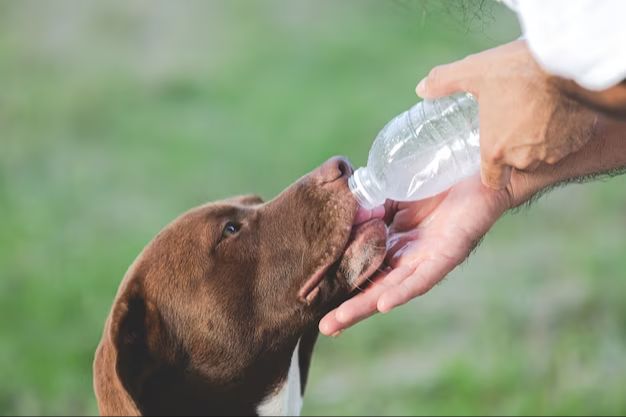Introduction
A slimy film can often develop at the bottom and sides of a dog’s water bowl. While unsightly, this film is quite common. The technical term for this slimy buildup is biofilm. Biofilm consists of a thin layer of bacteria, fungi, and protozoa encased in a matrix made up of sugar and protein molecules.
This biofilm forms when organic materials like saliva, food particles, and algae accumulate in the dog’s water bowl. Over time, these materials provide nourishment for microorganisms to multiply and generate the slimy film. The warm, moist conditions inside the bowl also promote biofilm growth.
While unpleasant to look at, a small amount of biofilm in your dog’s water bowl is usually harmless. However, letting it build up can potentially pose health risks for your dog. This article will examine the causes of slimy dog bowls, prevention methods, when to replace bowls, and possible health implications.
Saliva
One of the main reasons dog water bowls get slimy is because of saliva residue. When dogs drink from bowls, they leave behind traces of saliva. This saliva contains bacteria and enzymes that help dogs digest their food. However, these bacteria continue to live and multiply in the water bowl.

As the bacteria grows, it leaves behind a slippery, slimy film on the bowl’s surface. The slime is essentially a buildup of bacteria, proteins, and minerals from your dog’s saliva. While a small amount of saliva residue is harmless, letting it accumulate can provide an ideal breeding ground for microorganisms.
Food Particles
One of the main culprits behind slimy dog bowls is leftover food particles. When your dog eats, bits of kibble, canned food, or table scraps often get left behind in the bowl. Over time, these food remnants decompose and break down, leaving a slimy film on the bowl’s surface.

Wet dog food is especially prone to leaving behind residue. The moisture helps bind particles to the bowl. As the food bits sit in water, bacteria and mold starts to grow, creating a slimy buildup.
Dried kibble can leave behind a similar slimy film too. Even though kibble starts off dry and hard, contact with moisture softens it up. The starches and proteins in the kibble provide the perfect nutrients for microorganisms to thrive.
In addition, oils and fats from meats, fish, eggs, or other ingredients can congeal on the bowl’s surface. Over time these fats turn rancid and smelly, adding to the slimy coating.
Vigilant cleaning is the best way to combat food buildup. Use a scrub brush to remove all traces of food after every meal. This will prevent leftovers from decomposing into a slimy mess.
Algae
Bowls left outside, especially in direct sunlight, are prone to algae growth. Algae are plant-like organisms that live in water and thrive in warm, wet environments exposed to sunlight. The greenish fuzz that appears on the sides and bottom of outdoor water bowls is usually algae.

As algae multiply, they form a slimy film that sticks to the bowl. This provides an ideal breeding ground for bacteria and a foul taste and smell for your dog. In addition, some types of algae can produce toxins harmful to dogs if ingested.
To prevent algae growth, bring your dog’s water bowl inside when not in use, and scrub the bowl regularly to remove any algae before it accumulates.
Why Tap Water Affects Bowl Cleanliness
Tap water contains minerals and additives like chlorine that can leave residue. As the water evaporates, these minerals and chemicals are left behind on the surface of the bowl.
Hard water is especially problematic. The minerals in hard water interact with a dog’s saliva to create a sticky film. Areas with hard water tend to have higher concentrations of calcium and magnesium which bind to the bowl.
Even filtered water can leave behind trace elements. Unless purified by reverse osmosis or distillation, most filtered water still contains some dissolved solids.
Additionally, the metals and plasticizers in a bowl may react with additives in the water. This can accelerate the buildup of cloudy residue.
Using bottled or distilled water can help reduce mineral buildup. But saliva and food bits will still stuck to the bowl overtime. More thorough cleaning is needed to fully prevent slime.
Plastic Bowls
One common reason dog bowls get slimy is due to the material they’re made from. Plastic bowls have microscopic nooks and crannies that allow saliva, food particles, and moisture to collect inside them over time.
This provides an ideal environment for bacterial growth. As more gunk accumulates in these tiny crevices, a slimy film will begin to develop on both the inside and outside of the bowl.
Plastic also has a porous surface, so smells and stains can easily soak in. This means that even after washing, the bowl will retain traces of the slimy film.
High-quality stainless steel bowls with a perfectly smooth surface are less likely to accumulate gunk and bacteria. But plastic bowls are cheaper and more common.
Preventing a Slimy Dog Bowl
Here are some tips to prevent your dog’s water bowl from getting that nasty slimy buildup:
Clean Daily: Give your dog’s bowl a quick scrub with soap and hot water every day. This will remove saliva, food particles, and some algae before it can accumulate.
Use Stainless Steel or Ceramic: Bowls made from plastic tend to get slimy faster. Stainless steel and ceramic surfaces are less porous and easier to clean.
Change Water Frequently: Don’t leave standing water in the bowl for more than a day. Refresh your dog’s water supply at least once or twice a day.
Avoid Sunlight Exposure: Place your dog’s water bowl in a shaded spot. Direct sunlight promotes the growth of algae and slime.
Taking these simple preventative steps can help keep your pup’s water bowl clean, fresh, and slime-free!
Health Risks
If your dog ingests slimy gunk from their water bowl, it could cause them to get sick. The primary health concerns stem from bacteria and algae that can accumulate in standing water over time.

Dog bowls with stagnant water can become breeding grounds for harmful bacteria like E. coli or Salmonella. These bacteria thrive in the warm, moist environment and can reach high levels over days or weeks.
Blue-green algae may also grow in dog bowls, releasing toxins into the water. Ingesting algae-contaminated water could cause vomiting, diarrhea, or liver damage in dogs.
For these reasons, it’s important not to let the slime in your dog’s water bowl go unchecked. Replacing water frequently and washing bowls regularly can help prevent potentially dangerous buildups of bacteria and algae.
When to Toss
Even with diligent cleaning, over time dog water bowls can become too dirty and worn to use safely. There are a few signs that indicate it’s time to toss an old bowl and get a fresh replacement:
-
The bowl has visible dark stains or cloudiness that won’t scrub off. These stains indicate bacteria growth that could make your dog sick.
-
There are greasy residues or slimy biofilm clinging to the bowl’s surface that reappears quickly after washing. This suggests the bowl’s porous surface can’t be fully sanitized.
-
The bowl shows signs of damage like deep scratches, cracks, or missing pieces of material. Bacteria and mold can thrive in damaged areas.
-
You notice a persistent bad smell coming from the bowl, even after washing. Lingering odors mean contaminants remain.
-
Your dog repeatedly refuses to drink from the bowl over time. This could signal an issue with the bowl’s cleanliness or quality.
If your dog’s water bowl shows any of these warning signs, play it safe and replace it. Look for a new bowl made of non-porous materials that are easy to disinfect.
Conclusion
The slime that accumulates in dogs’ water bowls has several causes. It is often due to residue from a dog’s saliva, tiny food particles, or algae when the water sits for long periods. Plastic bowls tend to accrue more slime, likely due to scratches that allow bacteria to grow. While some slime is normal, it’s smart to regularly wash and replace bowls to ensure fresh, clean water. Excessive sliminess can indicate poor water quality or health issues for the dog. Overall, being aware of slime and taking steps to remove it will benefit a dog’s hydration and health.
